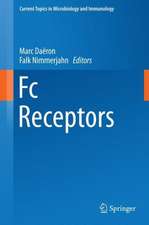Molecular and Cellular Mechanisms of Antibody Activity
Editat de Falk Nimmerjahnen Limba Engleză Hardback – 22 mai 2013
| Toate formatele și edițiile | Preț | Express |
|---|---|---|
| Paperback (1) | 1284.08 lei 6-8 săpt. | |
| Springer – 17 iun 2015 | 1284.08 lei 6-8 săpt. | |
| Hardback (1) | 1289.90 lei 6-8 săpt. | |
| Springer – 22 mai 2013 | 1289.90 lei 6-8 săpt. |
Preț: 1289.90 lei
Preț vechi: 1357.80 lei
-5% Nou
Puncte Express: 1935
Preț estimativ în valută:
246.85€ • 268.04$ • 207.36£
246.85€ • 268.04$ • 207.36£
Carte tipărită la comandă
Livrare economică 23 aprilie-07 mai
Preluare comenzi: 021 569.72.76
Specificații
ISBN-13: 9781461471066
ISBN-10: 1461471060
Pagini: 300
Ilustrații: X, 294 p.
Dimensiuni: 155 x 235 x 22 mm
Greutate: 0.58 kg
Ediția:2013
Editura: Springer
Colecția Springer
Locul publicării:New York, NY, United States
ISBN-10: 1461471060
Pagini: 300
Ilustrații: X, 294 p.
Dimensiuni: 155 x 235 x 22 mm
Greutate: 0.58 kg
Ediția:2013
Editura: Springer
Colecția Springer
Locul publicării:New York, NY, United States
Public țintă
ResearchCuprins
IgM and IgD in infection and inflammatory diseases.- Immunoglobulin A – molecular mechanisms of function and role in immune defense.- Crystal structures of human IgG Fc-fragments and their complexes with Fc Receptors.- The role of IgG in immune responses.- Molecular and cellular pathways involved in the anti-inflammatory activity of IgG.- Example of the Pathogenic Potential of Two Sets of Autoantibodies: Anti-RBC and IgG3 RF Cryoglobulins.- Cross-talk between antibodies, IgG Fc receptors and the complement system.- Regulation of immunological responses by the neonatal Fc receptor for IgG, FcRn.- Antibody mediated regulation of humoral immunity.- Engineered antibody derivatives in preclinical and clinical development.
Caracteristici
Full-color figures illustrate difficult concepts Written by renowned experts in the field Incorporates cutting-edge research and new discoveries Includes supplementary material: sn.pub/extras



























